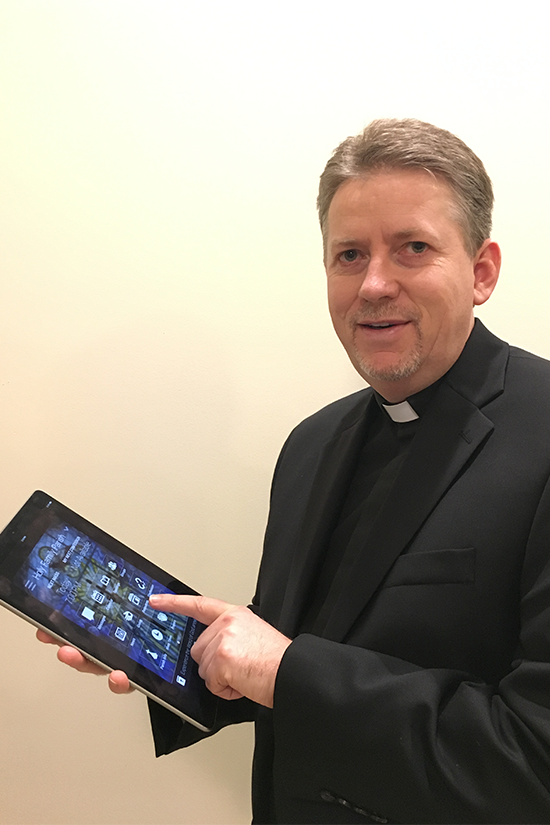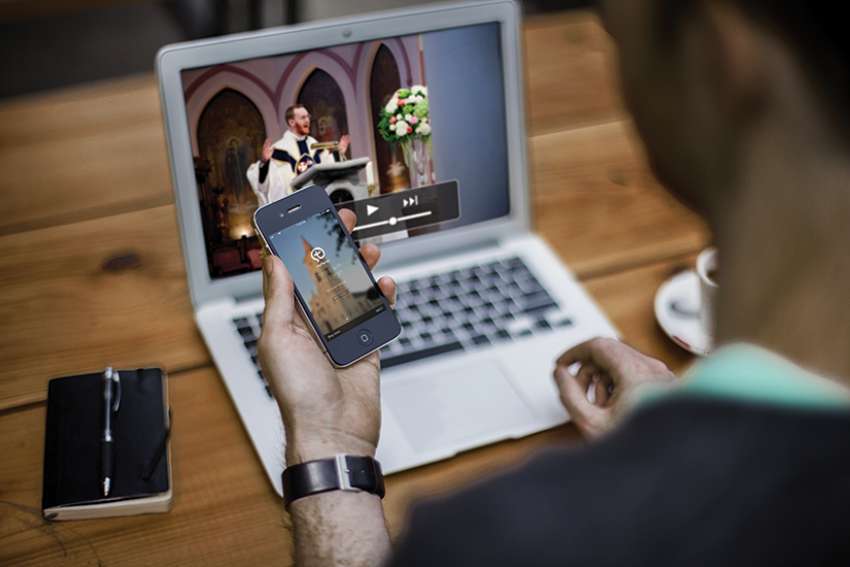That’s good news for clergy, who have a growing urgency to harness technology tools, as well as plug into social media via live-streaming and podcasting, to ensure the Church keeps up in the fast-changing cybersphere.
“Other denominations, they are at least 10 or 15 years ahead of us with mass media and social media,” said Fr. Laszlo Nagy, pastor of Holy Family Parish in Whitby, Ont. “All my staff attended webinars from other denominations and these are the tools that they are using.”
The challenge to the Church to widen its digital reach is being felt world-wide and, perhaps especially, in Rome.
Pope Francis and the Vatican set an example with various online strategies, including three different apps (including The Pope App) and regular Francis videos. The Vatican has four million followers between its Facebook, Twitter, YouTube and Instagram platforms, according to figures released this month. The Pope’s own Twitter account has more than 44 million followers in nine languages.
Nagy is currently working with the Archdiocese of Toronto to pilot test the myParish app, a communications hub which allows pastors and parishioners to stay connected.
 “We use it for conversation, engage the people to get involved in conversation,” he said.
“We use it for conversation, engage the people to get involved in conversation,” he said.
It is just one of many apps that have emerged over the last several years as the Church grapples both with technology and in the never-ending task of keeping parishioners engaged with their faith.
“Even in the last four or five years social media changed our thinking and our attitude,” said Nagy. “And this is what I’m talking about sometimes in my homily, how social media is changing even our faith.”
Nagy remembers when he first came to Holy Family Parish in 2008 and the church didn’t even have Internet. Since then, he feels as though he and his staff have been playing catch-up, attending workshops to learn how they can bring the Church’s message online.
If the Church wants to be relevant in today’s technological age, Nagy said, it must transform from being a maintenance Church to a missionary Church.
“The maintenance Church is when we are just here and we wait for the people to come. … I baptize you, I sacramentalize you and I catechize you and that’s it,” he said. “The missionary Church, it means we go out and we give testimony of our faith…. And through our testimony, hopefully, we may gather the scattered and return them to Christ.”
Nagy announced the launch of the parish’s myParish page from the pulpit on Dec. 2, the first Sunday of Advent.
Through the U.S.-built app, parishioners have access to daily readings, Mass times, event calendars and weekly bulletins in digital format. Nagy and the parish staff have also tried new features, such as parish group discussion boards, “homily teasers” and a parish blog.
The parishioners seem to be embracing the app well, said Nagy. Since the parish launched the free app, more than 1,200 of the parish’s 5,600 households have registered.
Most of them are the tech-savvy young people, but parish staff have also provided help for older parishioners on how to use the app.
“There are many of (older parishioners) who are afraid to set up accounts,” said Nagy. “They are not open, people of a certain generation, to have any kind of apps because they don’t want to give out personal information.”
If the trial succeeds, the Archdiocese of Toronto is looking at the possibility of adopting the app for all 221 parishes. The Diocese of Alexandria-Cornwall adopted the myParish app for its 27 parishes last year.
Nagy said he is excited about the potential of the app because it is time the Church started catching up with the times and preach from the digital, as well as church, pulpit.
Fr. John Jasica live-streams three of the four Masses at St. George Parish in London, Ont.
“When we take a look at what people are using in terms of social media and all that, we have to be relevant in those areas,” said Jasica. “In the last year and a half, we’ve live-streamed some of our Masses for our homebound ... but also as a form of evangelization. We’ve had people from different parts of the world that would tune in.”
Jasica and the parish staff also run two podcasts. Faith & Works is an online parish book club hosted on the parish website. Every week, Jasica offers commentary on a chapter of Matthew Kelly’s Rediscover Catholicism.
The second podcast is his own, where he posts Sunday homilies and what he calls “homily warm-ups” during the week as preparation for Sunday Mass.
“My iPhone is always close by, whether it’s for emergency calls or for the apps that I use,” said Jasica. “For Liturgy of the Hours and praying every day (apps are) very convenient because you don’t have to flip pages or anything…. In the parish, we’ve really used Facebook and Twitter as opportunities for sharing parish events but also encouraging people to deepen their faith.”
Fr. Chris Pietraszko also likes to keep his phone nearby. He said it’s like walking around with an entire library in his back pocket.
“It’s very convenient in that way because you don’t have to run back to the office if you want to spend some time in prayer in front of the Blessed Sacrament,” said Pietraszko, who is associate pastor at Corpus Christi Parish in Windsor, Ont. “The one thing I always try to do, though, is if I’m going to use these resources, I make sure I’m not distracted.”
Pietraszko runs his own podcast named after Pope John Paul II’s 1998 encyclical, Fides et Ratio (Faith and Reason). Every week, he places his iPhone (set to airplane mode to ensure it does not receive a call or text message) on the podium to record his homilies.
He also posts reflections from catechism classes he teaches at his parish called “The School of Faith and Reason” and occasionally he interviews special guests.
“I pay for (the podcast) myself. It doesn’t come out of the parish,” said Pietraszko. “It’s kind of making the ability to evangelize a little more widespread and so I think it’s a very positive force in the Church.”
Facebook and Twitter remain the bread and butter apps for Pietraszko’s parish, as with many tech-savvy parish communities. With social media, the lay faithful have access to both local and international communities.
Fr. Alex Laschuk, associate judicial vicar at the Marriage Tribunal office in the Archdiocese of Toronto, said that while it is important for the Church to take advantage of these tools, priests must be careful about how they use these new media.
“The Church is not a democracy and sometimes a priest with 20,000 followers or whatever can have some opinions that can be very popular and sometimes, can be maybe not appropriate,” said Laschuk. “So those are some things to be cautious about.”


